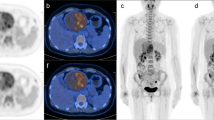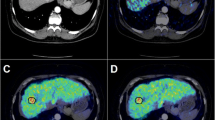Abstract
Purpose
To prove the sensitivity of dual-time-point imaging with 18F-flourodeoxyglucose-positron emission tomography (18F-FDG-PET) of the liver to evaluate possible changes in the tumor-to-background ratio considering an improved detection rate of liver lesions.
Procedures
Image acquisition for the first whole-body scan started at a mean time point of 69 min (55–110 min). The mean time interval between the injection of 18F-FDG and the second delayed scan was 100 min (85–166 min).
Results
Of 90 proven liver metastases in 34 patients, the first scan detected 53 (59%) liver lesions correctly, whereas in the second, delayed scan 81 (90%) lesions were diagnosed correctly (p<0.001). The mean Standardized uptake values in the first and second delayed scan were 6.59 g/ml versus 8.09 g/ml, respectively (p<0.001). Tumor-to-background ratio of the first and second delayed scan were 2.0 and 2.7, respectively (p = 0.04).
Conclusions
Dual-time-point-imaging of the liver showed a significant increase of tumor-to-background ratio and hypermetabolic lesion diameter. Although, 30% of all verified liver lesions could only be detected in the second delayed scan 10% of all malignant liver lesions were missed with FDG-PET.




Similar content being viewed by others
References
American Cancer Society (1999) Cancer facts and figures: 1999. American Cancer Society, Atlanta, GA
Lehnert T, Knaebel HP, Duck M, Bulzebruck H, Herfarth C (1999) Sequential hepatic and pulmonary resections for metastatic colorectal cancer. Br J Surg 86:241–243
Nakamura S, Suzuki S, Baba S (1997) Resection of liver metastases of colorectal carcinoma. World J Surg 21:741–747
Kubo Y, Kurita A, Saeki T, Yokoyama N, Tanada M, Takiyama W, Saeki H, Takashima S (1996) Chemotherapy for peritoneal dissemination in gastric cancer under ureteral catheterization. Gan To Kagaku Ryoho 23:1951–1957
Huebner RH, Park KC, Shepherd JC et al (2000) A meta-analysis of the literature for the whole-body FDG PET detection of recurrent colorectal cancer. J Nucl Med 41:1177–1189
Brix G, Ziegler SI, Bellemann ME, Doll J, Schosser R, Lucht R, Krieter H, Nosske D, Haberkorn U (2001) Quantification of [18F]FDG uptake in the normal liver using dynamic PET: impact and modeling of the dual hepatic blood supply. J Nucl Med 42:1265–1273
Weber G, Cantero A (1955) Glucose-6-phosphatase activity in normal, pre-cancerous, and neoplastic tissues. Cancer Res 15:105–108
Weber G, Morris HP (1963) Comparative biochemistry of hepatomas. III. Carbohydrate enzymes in liver tumors of different growth rates. Cancer Res 23:987–994
Matthies A, Hickeson M, Cuchiara A, Alavi A (2002) Dual time point 18F-FDG PET for the evaluation of pulmonary nodules. J Nucl Med 43:871–875
Hamberg LM, Hunter GJ, Alpert NM, Choi NC, Babich JW, Fischman AJ (1994) The dose uptake ratio as an index of glucose metabolism: useful parameter or oversimplification? J Nucl Med 35:1308–1312
Lodge MA, Lucas JD, Marsden PK, Cronin BF, O'Doherty MJ, Smith MAA (1999) PET study of 18-FDG uptake in soft tissue masses. Eur J Nucl Med 26:22–30
Zhuang H, Pourdehnad M, Lambright ES, Yamamoto AJ, Lanuti M, Li P, Mozley PD, Rossman MD, Albelda SM, Alavi A (2001) Dual time point 18F-FDG PET imaging for differentiating malignant from inflammatory processes. J Nucl Med 42:1412–1417
Newcombe RG (1998) Improved confidence intervals for the difference between binomial proportions based on paired data. Stat Med 17:873–890
Rohren EM, Turkington TG, Coleman RE (2004) Clinical applications of PET in oncology. Radiology 231:305–332
Kinkel K, Lu Y, Both M, Warren RS, Thoeni RF (2002) Detection of hepatic metastases from cancers of the gastrointestinal tract by using noninvasive imaging methods (US, CT, MR imaging, PET): a meta-analysis. Radiology 224:748–756
Munk OL, Bass L, Roelsgaard K, Bender D, Hansen SB, Keiding S (2001) Liver kinetics of glucose analogs measured in pigs by PET: importance of dual-input blood sampling. J Nucl Med 42:795–801
Beaulieu S, Kinahan P, Tseng J et al (2003) SUV varies with time after injection in 18F-FDG PET of breast: characterisation and method to adjust for time differences. J Nucl Med 44:1044–1050
Nishiyama Y, Yamamoto Y, Fukunaga K, Kimura N, Miki A, Sasakawa Y, Wakabayashi H, Satoh K, Ohkawa M (2006) Dual-time-point 18F-FDG PET for the evaluation of gallbladder carcinoma. J Nucl Med 47:633–638
Kumar R, Loving VA, Chauhan A, Zhuang H, Mitchell S, Alavi A (2005) Potential of dual-time-point imaging to improve breast cancer diagnosis with 18F-FDG PET. J Nucl Med 46:1819–1824
Sanghera B, Wong WL, Lodge MA, Hain S, Stott D, Lowe J, Lemon C, Goodchild K, Saunders M (2005) Potential novel application of dual time point SUV measurements as a predictor of survival in head and neck cancer. Nucl Med Commun 26:861–867
Conrad GR, Sinha P (2003) Narrow time-window dual-point 18F-FDG PET for the diagnosis of thoracic malignancy. Nucl Med Commun 24:1129–1137 Nov
Patz EF Jr, Lowe VJ, Hoffman JM, Paine SS, Burrowes P, Coleman RE, Goodman PC (1993) Focal pulmonary abnormalities: evaluation with F-18 fluorodeoxyglucose PET scanning. Radiology 188:487–490
Hubner KF, Buonocore E, Gould HR, Thie J, Smith GT, Stephens S, Dickey J (1996) Differentiating benign from malignant lung lesions using “quantitative” parameters of FDG PET images. Clin Nucl Med 21:941–949
Torizuka T, Zasadny KR, Recker B, Wahl RL (1998) Untreated primary lung and breast cancers: correlation between F-18 FDG kinetic rate constants and findings of in vitro studies. Radiology 207:767–774
Cook GJ, Maisey MN, Fogelman I (1999) Normal variants, artefacts and interpretative pitfalls in PET imaging with 18-fluoro-2-deoxyglucose and carbon-11 methionine. Eur J Nucl Med 26:1363–1378
Kato T, Fukatsu H, Ito K, Tadokoro M, Ota T, Ikeda M, Isomura T, Ito S, Nishino M, Ishigaki T (1995) Fluorodeoxyglucose positron emission tomography in pancreatic cancer: an unsolved problem. Eur J Nucl Med 22:32–39
Hustinx R, Smith RJ, Benard F, Bhatnagar A, Alavi A (1999) Can the standardized uptake value characterize primary brain tumors on FDG-PET? Eur J Nucl Med 26:1501–1509
Zhuang H, Duarte PS, Pourdehnad M, Li P, Alavi A (2000) Standardized uptake value as an unreliable index of renal disease on fluorodeoxyglucose PET imaging. Clin Nucl Med 25:358–360
Thie JA (2007) Optimizing dual-time and serial positron emission tomography and single photon emission computed tomography scans for diagnoses and therapy monitoring. Mol Imaging Biol 9(6):348–356
Author information
Authors and Affiliations
Corresponding author
Rights and permissions
About this article
Cite this article
Dirisamer, A., Halpern, B.S., Schima, W. et al. Dual-Time-Point FDG-PET/CT for the Detection of Hepatic Metastases. Mol Imaging Biol 10, 335–340 (2008). https://doi.org/10.1007/s11307-008-0159-y
Received:
Revised:
Accepted:
Published:
Issue Date:
DOI: https://doi.org/10.1007/s11307-008-0159-y




